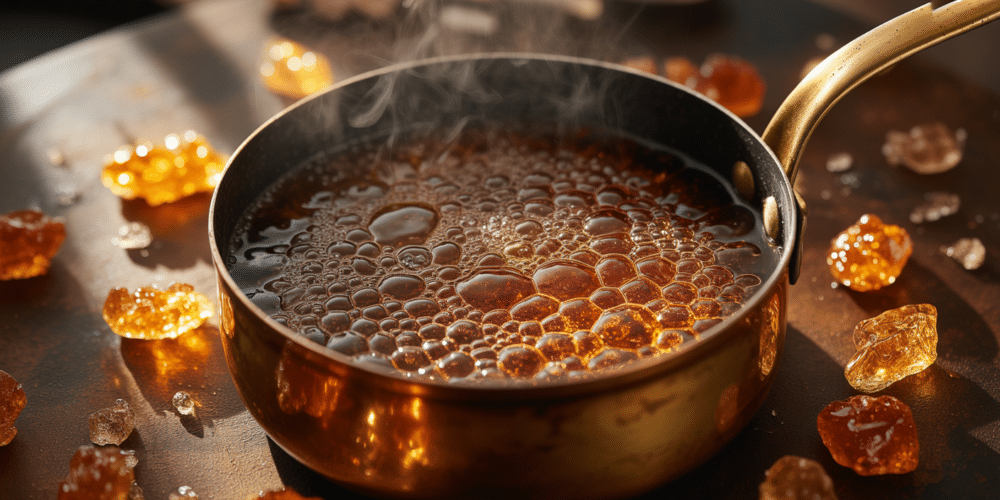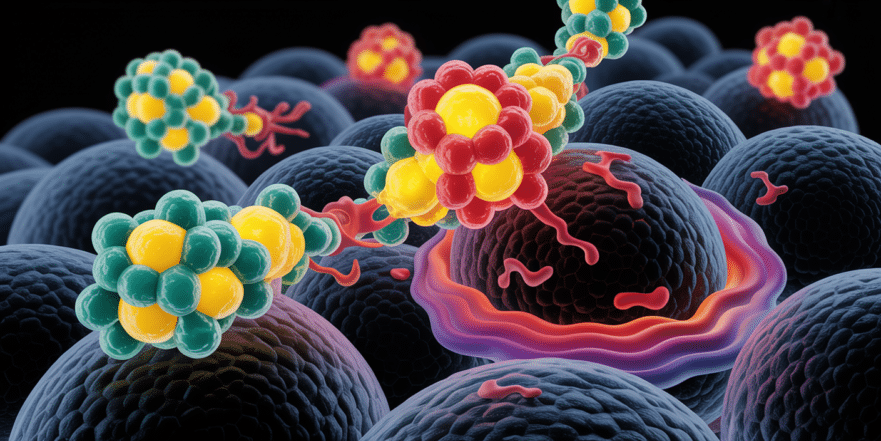
Have you ever stopped to think about what’s actually happening inside your body after you eat something sugary? We all know that sugar is flowing through your bloodstream, but what you might not realize is that this sugar is actively reacting with other things in your body. It bumps into proteins, and it bumps into fats, and when it does, it creates a sticky, inflammatory substance that can make you feel downright cruddy, accelerate the aging process, and contribute to chronic health issues.
This damaging process is called glycation, and it’s a lot like caramelizing an onion. When you apply heat to the sugars in an onion, they turn brown, sticky, and irreversibly change. A similar, albeit slower, process happens inside you when excess sugar binds to your body’s proteins and fats, creating harmful compounds known as Advanced Glycation End-products, or AGEs. These AGEs are a major source of inflammation and oxidative stress, damaging your cells from the inside out. The good news is that there’s a powerful, yet surprisingly simple and inexpensive, way to put a stop to this process in its tracks. It’s a dipeptide called carnosine, and in this article, I’m going to teach you exactly what it is, how it works, and how you can use it to protect your body from the damaging effects of sugar.
Key Takeaways
- Glycation: A natural process where sugar molecules in your bloodstream attach to proteins or fats, forming harmful new molecules.
- Advanced Glycation End-products (AGEs): These are the harmful compounds formed by glycation. They cause inflammation and oxidative stress, contributing to aging, skin damage, joint stiffness, and chronic diseases.
- Carnosine’s Role: Carnosine is a natural compound that acts as a powerful anti-glycation agent. It intercepts and neutralizes the catalysts that kickstart the glycation process, effectively stopping it before it can cause damage.
- Benefits of Carnosine: By blocking AGE formation, carnosine helps reduce inflammation, protect DNA, support brain health, improve insulin sensitivity, and may even reduce the joint pain and brain fog some people experience after eating sugar.
- How to Use It: Carnosine can be used long-term to build up protective levels in your tissues (3-6 grams daily) or tactically before a high-sugar meal (about 2 grams) to mitigate immediate damage.
1. What is Glycation? The “Caramelizing” Effect in Your Body

You might think that combining a protein and a carbohydrate, like eating chicken and a banana, is perfectly healthy—and you’d be right. So why does this same combination become so problematic inside your body? The issue isn’t the combination itself, but the environment and the presence of a catalyst. When you have high levels of sugar in your bloodstream, it creates the perfect environment for glycation to occur. Think about that caramelizing onion again. You have the onion (which contains sugar and proteins), but nothing happens until you apply heat. In your body, high blood sugar and certain reactive molecules act as the “heat.”
This process creates AGEs, which are essentially useless, damaged cells. They become sticky, dysfunctional, and start leaking inflammatory signals throughout your body. They are like little cesspools of garbage that gum up your cellular machinery. Once a protein has been glycated—once that onion has been caramelized—you can’t reverse it. The damage is done. This is why preventing glycation in the first place is so critically important for your long-term health and vitality.
2. Advanced Glycation End-Products (AGEs): The Hidden Drivers of Aging and Inflammation

So, what do these AGEs actually do once they’re formed? They wreak havoc. These compounds are a primary driver of oxidative stress, which is a fundamental mechanism of aging and disease. They can build up in virtually any tissue in your body. When they accumulate in your skin, they damage collagen and elastin, leading to the wrinkles, stiffness, and leathery appearance we associate with old age. If you’ve ever seen someone who looks significantly older than their years, there’s a good chance they have a high burden of AGEs.
But the damage is more than skin deep. AGEs can build up in the cartilage of your joints, causing stiffness and pain. They can accumulate in the lenses of your eyes, contributing to cataracts. They damage your DNA, which can lead to cellular dysfunction. Furthermore, they trigger a massive inflammatory response, causing your immune system to release a cascade of inflammatory cytokines. This chronic, low-grade inflammation is the root cause of many modern diseases, making it incredibly difficult for your body to even manufacture energy properly.
3. How Carnosine Acts as Your Body’s Glycation Shield
This is where carnosine comes in as the hero of the story. To understand how it works, you need to know about a key catalyst in the glycation process called methylglyoxal. This is one of the main “carbonyl reactive species” that kicks the whole damaging reaction into gear. Without it, the sugar and protein are far less likely to bind and cause problems. A study published in Applied and Environmental Microbiology found that carnosine has a remarkable ability to neutralize methylglyoxal directly.
In essence, carnosine sacrifices itself. It intercepts and binds to these reactive species, stopping them in their tracks before they can ever initiate the glycation process. By neutralizing the catalyst, you prevent the entire chain reaction. Your body is much better at clearing out the precursor metabolites than it is at clearing out a fully formed AGE. Carnosine acts as a shield, protecting your valuable proteins and fats from becoming sugar-damaged junk.
4. The Link Between Glycation, Inflammation, and Insulin Resistance

One of the most significant consequences of a high-AGE diet and lifestyle is insulin resistance. For years, we thought high blood sugar directly caused insulin resistance, but we’re now understanding the relationship more clearly. It’s more likely that the chronic inflammation caused by factors like AGEs is the primary cause of insulin resistance, and the high blood sugar and insulin issues are a secondary effect.
When your body is constantly inflamed, your cells become “numb” to the signal of insulin. They don’t respond properly, which means sugar can’t get out of the bloodstream and into the cells to be used for energy. Your pancreas then works overtime, pumping out even more insulin to try and force the message through. This vicious cycle of high inflammation, high blood sugar, and high insulin is the foundation of metabolic syndrome and type 2 diabetes. By using carnosine to block the formation of inflammatory AGEs, you can help break this cycle and support your body’s sensitivity to insulin.
5. Carnosine for Your Brain: Protecting Cognitive Function

The protective effects of carnosine aren’t just for your body; they are critically important for your brain as well. Your brain is highly susceptible to damage from AGEs. As these compounds build up in neural tissue over the years, they damage DNA and are believed to be a major contributor to the age-related cognitive decline we see so often. The initial clues about carnosine’s powerful effects on glycation actually came from brain research.
A fascinating study published in the journal Neurotherapeutics found that supplementation with carnosine led to increased cognitive function. Researchers, observing this high-level benefit, began to investigate the underlying mechanisms, which led them to its powerful anti-glycation effects. Protecting your brain from this sticky, inflammatory damage is one of the most compelling reasons to consider adding carnosine to your health regimen, especially as you get older.
6. How to Use Carnosine: Dosing and Timing for Maximum Effect
Now for the practical part you’ve been waiting for: how do you actually use carnosine? The great news is that it’s very safe. Your body naturally produces it, and you also get it from eating meat. However, the amount you get from food doesn’t seem to be enough to significantly raise the levels within your tissues to a therapeutic, protective level. This is where supplementation comes in.
For long-term, systemic protection, the research points towards building up your tissue levels over time. This involves taking a consistent daily dose, with studies often using between three to six grams per day. This allows carnosine to saturate your muscles and brain, providing a constant shield against glycation.
There’s also a short-term, tactical way to use it. Let’s say you know you’re going to have a dessert, a cheat meal, or a particularly high-carbohydrate meal. You can take a dose of about two grams of carnosine 30 to 60 minutes beforehand. This provides an immediate buffer, helping to neutralize the catalysts that will be generated from that influx of sugar, reducing the glycation risk from that specific meal. Many people who report feeling joint pain, stiffness, or brain fog after sugar may be experiencing a rapid glycation event, and this tactical dosing could provide significant relief.
7. Carnosine vs. Beta-Alanine: What’s the Difference?
If you’ve spent any time in the fitness world, you may have heard of a supplement called beta-alanine. It’s famous for its ability to delay muscle fatigue during a workout, often causing a harmless tingling sensation. What you may not know is that beta-alanine is actually one half of the carnosine molecule. Carnosine is a dipeptide, meaning it’s made of two amino acids: beta-alanine and histidine.
Your body can make its own carnosine by combining the beta-alanine you consume with the histidine that’s already available. For this reason, taking beta-alanine (typically 4-6 grams) can indeed raise your body’s carnosine levels and provide some of these anti-glycation benefits. For a long time, this was the primary way people supplemented to boost carnosine. However, more evidence is now showing that taking carnosine directly is a highly effective, and perhaps more direct, way to achieve these protective effects without the tingling side effect of beta-alanine.
Conclusion
The process of glycation is a silent and insidious driver of aging and chronic disease, turning the sugar in your bloodstream into inflammatory compounds that damage your body from the inside out. While the best defense is always a healthy lifestyle with minimal processed sugar, we don’t live in a perfect world. Carnosine offers a powerful, safe, and scientifically-backed shield to protect your cells, tissues, and DNA from this “caramelizing” effect. Whether you use it daily for long-term protection or tactically before a treat, you are giving your body a crucial tool to fight inflammation, support your metabolism, and keep you feeling and looking younger for longer.
Source: Thomas Delauer

